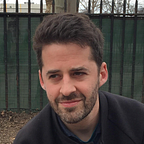Shrub and the advent of exposure poetry
Erasure is a kind of poetry in which we erase existing texts to reveal new ones. Austin Kleon’s Newspaper Blackout collection is an example:
If erasure is the art of selectively erasing found text, then let’s call its opposite exposure — the art of selectively exposing found text.
Exposure is importantly different than transcription, a field that Kenneth Goldsmith has explored/exhausted (see for example his 800 page poem “Day,” a transcription of an issue of the New York Times).
Transcription removes text style, while exposure preserves it; the difference amounts to “Match Destination Formatting” vs “Keep Source Formatting” in your Microsoft Word Paste Options.
So in order to make an exposure poem, we need a camera to capture the text as we see it. That’s where Shrub comes in. It’s a neat app for iOS, in which you can paint what your camera is viewing onto a canvas.
When used on a page in a book, you might end up with something like this:
But the cool thing about Shrub and exposure poetry is that your source doesn’t have to be the printed page — there’s text all around us to expose. Here’s what I saw right outside my office:
Shrub is probably the best tool I’ve used to connect with the text that surrounds me in my everyday life. Excited to see how other people use it.
